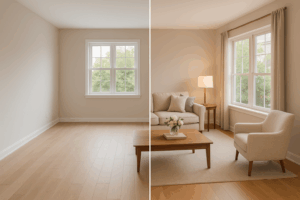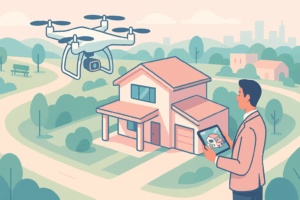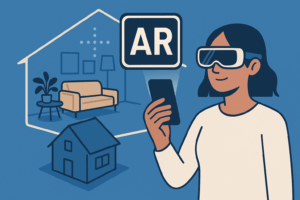Instagram, TikTok, YouTube, Facebook… marketing can feel overwhelming, right? Each platform has its own set of rules, and navigating them can feel like a never-ending puzzle. Plus, not to mention, we already know that photos aren’t enough for real estate listings. You must consider a real estate video strategy.
However, there’s one simple decision you can make that will help shape the rest: should your video go vertical or horizon?
This is a stylistic choice as much as it’s a way to tap into the value of each platform. In this guide, we’ll showcase the nuances of each format and help you decide when to go wide or tall.
Understanding the Audience and Platform
The major key to success in marketing is knowing your audience. Different demographics flock to different platforms – and each has its own quirks and preferences when it comes to video format.
Let’s break down where your potential buyers are hanging out and how they’re viewing your content. This is how you can showcase properties in the best light on the right screen.
Audience Demographics
Gen Z and Millennials are typically the primary users of mobile-first platforms like TikTok and Instagram. This audience prefers vertical videos – and that makes sense. It’s how they naturally hold and use their smartphones.
Stats back it up, too. Recent studies show that vertical videos on mobile devices have a 90% higher completion rate compared to horizontal ones among these younger viewers. They expect content to be immediately accessible and formatted for their screen without requiring them to change their viewing habits.
In contrast, Gen X and Boomers are more inclined to browse on desktops and laptops. For this demographic, horizontal videos provide a more comfortable and familiar viewing experience. They tend to engage with longer, more detailed walkthroughs that benefit from the widescreen aspect ratio of horizontal video.
This format offers a comprehensive view of properties, which can be particularly effective for this audience. Plus, it’s important to remember that it’s still the boomers’ real estate market. Catering to a younger crowd is important, but you must not forget the reality.
How These Videos Work: Platform Preferences Overview
Utilizing horizontal or vertical depends on the platform. Similar to photography, best practices in this department can help you get the most out of each social media platform. Here’s what each prefers:
Instagram and TikTok:
- Vertical (9:16) is preferred.
- Instagram Reels and Stories default to vertical, with horizontal videos automatically cropped.
- TikTok is designed for vertical viewing, optimized for mobile-first engagement.
YouTube:
- Horizontal (16:9) is the standard.
- While YouTube Shorts accommodates vertical videos, the platform’s traditional format remains horizontal, ideal for in-depth property tours.
LinkedIn:
- Horizontal (16:9) works best.
- The platform is oriented toward a professional audience, many of whom view content on desktops, making horizontal videos more effective.
Facebook:
- Supports both Horizontal (16:9) and Square (1:1) videos.
- Square videos can perform well on mobile, but horizontal videos are typically preferred for a traditional viewing experience.
Twitter/X:
- Primarily favors Horizontal (16:9) but supports Square (1:1) videos.
- Horizontal videos are more commonly used, providing a versatile format across different devices.
The Takeaway: Be sure to match the video format to the platform and audience. Vertical videos are more effective on platforms targeting younger users who consume content on mobile devices. Meanwhile, horizontal videos offer versatility and a more immersive experience. This makes them suitable for platforms and audiences that favor detailed property presentations.
Horizontal Vs. Vertical: Breaking Down Use Cases
Platform aside – what format makes the most sense for a use case? Choosing either horizontal or vertical depends on the content’s purpose and goal.
When you hit this concept right, your listing will really start to sing. In real estate, it’s all about finding that edge.
Horizontal Videos
Horizontal videos obviously offer a wider frame. This means they’re ideal for capturing expansive scenes and providing viewers with a comprehensive view. The format is best suited for platforms that favor long-form content and desktop viewing. When shot well, they provide a professional – and cinematic – look.
- Ideal for Comprehensive Property Tours and In-depth Walkthroughs: The horizontal format captures more context and detail. It allows viewers to see entire rooms or landscapes in a single frame. It’s a great choice for real estate tours to offer a full view of a property’s layout and features. Show off that view!
- Versatility Across Desktop Preferred Platforms: Platforms like YouTube have been built around horizontal videos. This makes the format a natural choice for detailed, immersive content. Horizontal videos also work well on LinkedIn and Facebook, where users often view content on larger screens.
Vertical Videos:
Imagine someone leisurely browsing listings on their phone – and then, boom, they can do a little tour of a property that catches their eye. This small act can provide them with some real context of the listing – and then eventually result in a sale further down the line.
- Best for Quick, Engaging Content: Vertical videos are effective for short, engaging clips, making them ideal for platforms like TikTok and Instagram Reels. Their format is naturally suited to how users hold their phones, providing a full-screen experience that doesn’t require viewers to rotate their devices.
- Mobile-first Viewing: Given that mobile traffic accounts for over half of global web usage, you have a big audience! Additionally, mobile-first platforms such as Instagram Stories and Snapchat are designed around this format.
- Effective for Short, Continuous Shots and Fast-Paced Edits: The vertical format is excellent for creating quick, continuous walkthroughs and engaging edits. It’s also more accessible for on-the-go content creation using smartphones. For real estate agents, it’s an easy way to share high-quality video content.
Plan Your Target: Creating with the End Format in Mind
Like any real estate photo or video shoot, be sure to make a plan. Know which format you need to use and build it into your shot list, which is the foundation of your entire shoot. This shapes how you frame each room, the gear you need, and how your video will ultimately connect with viewers across different platforms.
Planning for the Format
Make sure every shot works for your chosen format, so you don’t have to crop out important details or compromise on quality in post-production.
If you’re capturing a horizontal tour, focus on wide shots that encompass entire rooms. This format is perfect for showing off the full scope of a property, allowing viewers to get a comprehensive look. For vertical, think about depth and close-ups. It’s about zeroing in on specific features in a single frame. This works to engage mobile-first audiences.
Technical Considerations
Each format has its technical quirks, and knowing them can help you produce a smoother final product.
- Capturing in Vertical: Use a smartphone or vertical gimbal with a DSLR for vertical videos. Phones are naturally designed for vertical shooting and often come with built-in stabilization, making them an accessible choice for on-the-go content creation.
- Horizontal Shooting with Cropping Potential: If you’re shooting horizontal but want the option to crop for vertical later, keep your subject centered. This gives you the flexibility to adjust in post-production without losing key elements of the scene.
Avoiding Common Mistakes:
When balancing these two directions and formats, it’s easy to screw up basics like focus, framing, and composition.
- Maintaining Focus Across Formats: Keep the main subject in focus and centrally positioned, especially if you might crop the footage later. This approach ensures that no important details are lost during editing.
- Considering Framing and Composition: Horizontal videos require a wider perspective, so use the entire frame to create a balanced shot. In contrast, vertical videos need a tight focus, emphasizing height and centrality to keep the viewer’s attention on the main subject.
Planning will lead to a successful shoot. Remember, the key is to be intentional from the start.
Pro Tip: Utilize HomeJab’s Home Services to make sure your property shines in every department.
Maximizing Engagement with Each Format
It’s all about potential, potential, potential. Whether you’re working with vertical or horizontal videos, there are strategies to make sure your content stands out and holds the viewer’s attention.
Vertical Video Engagement:
Vertical videos are designed for quick consumption on mobile devices, which means they need to capture attention fast and keep it. It’s an opportunity to get intimate. Platforms like TikTok and Instagram favor vertical formats, so optimizing your videos for these spaces helps you tap the most value.
- Optimizing for Platforms: To engage users on TikTok and Instagram, make sure your vertical videos fit the platform’s norms and expectations. On TikTok, aim for snappy, attention-grabbing intros since users typically decide within the first few seconds if they’ll keep watching. Instagram Stories and Reels benefit from vertical videos that take up the full screen. This creates an immersive experience.
- Creating Engaging Content: Techniques like speed-up walkthroughs and continuous shots can make vertical videos more dynamic. A fast-paced walkthrough, especially with a slight speed-up effect, can quickly showcase a property’s best features without losing the viewer’s interest. Continuous shots help maintain a sense of flow, making the video feel more like a live experience rather than a series of clips.
Horizontal Video Engagement:
Horizontal videos offer a more expansive view, which makes them ideal for creating an immersive experience with a wide angle. You can really show the value and size of a property. They excel on platforms where viewers are more likely to sit back and take in longer content.
- Creating an Immersive Experience: Use the wider frame of horizontal videos to capture more of the environment. This gives viewers a comprehensive look at the property. This format is perfect for detailed walkthroughs – where you can move through each room and outdoor space – offering viewers a sense of the property’s scale and layout. It’s particularly effective on platforms like YouTube, where users are already expecting a more in-depth experience.
- Leveraging Longer Viewer Retention: Platforms like YouTube and Facebook are built for longer viewer retention, and horizontal videos are well-suited for this. Use this format to dive deeper into features and details that may not be immediately visible in a quick vertical shot. For example, you can create more in-depth tours, showcase specific design elements, or provide a narrative that walks viewers through the property’s story.
Know the Value of Horizontal vs. Vertical, Tap the Full Potential of a Real Estate Listing
Utilizing horizontal or vertical video isn’t just a technical decision. Instead, think of it as a strategic move that can shape how your properties are experienced by potential buyers. When you understand the nuances of each format, you can better align with your audience’s behavior and platform strengths.
The right can elevate a listing – and that makes it more engaging and memorable.
If you’re ready to tap into your ideal video format, we’re here to help. At HomeJab, we offer tailored video services that can help you capture every angle. Let’s get started!











